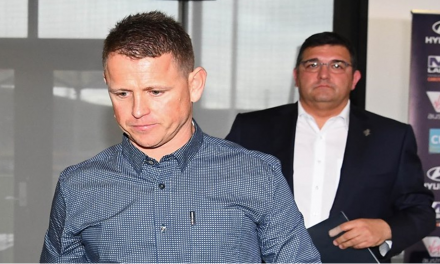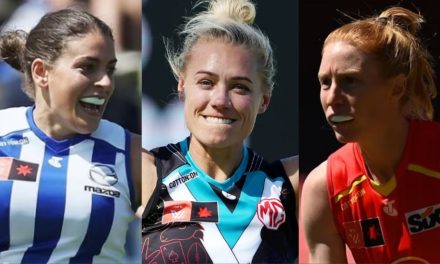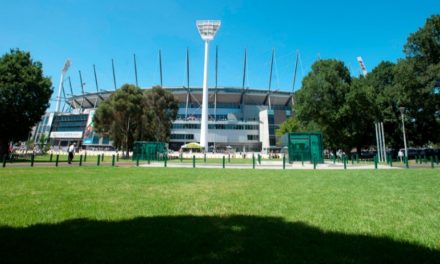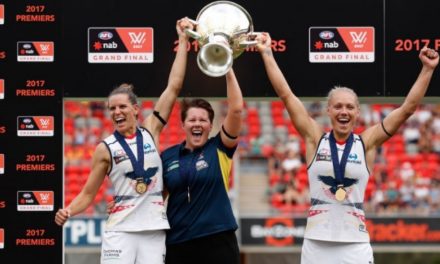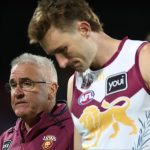Tim Harcourt says of all the options for a 20th AFL licence, a third WA team is probably the most robust financially.
It hasn’t taken AFL chief executive Andrew Dillon long to hose down the chances of a third Western Australian side as the league’s 20th team.
Of all the options for a 20th licence, a third WA team is probably the most robust financially. But would it add a new dimension to the league? Is there a demand? It’s an idea at least worth some investigation.
The race for a 20th team is a four (maybe five) horse race with a couple of outsiders.
The sentimental favourite of footy fans is definitely the Northern Territory. There could be a team in Darwin playing some games in Alice Springs when Darwin is still in wet season.
The problems are population (NT only has 252,200 people, less than half Tasmania), infrastructure (TIO stadium only holds 12,500), climate and tyranny of distance.
The NT’s taskforce says a team would lose $15 million a year commercially, so would need significant investment. But others say it would be worth it in terms of social impact. After the failure of ‘The Voice’ referendum, perhaps sport is one of the best vehicles for reconciliation, but significant work needs to be done on the economic case for a NT team.
There is the option of playing some games in Cairns as a team for Northern Australia, but Cairns has similar issues to Darwin in terms of climate and infrastructure, so would also need significant investment to develop footy in the north of the continent.
The second favourite is Canberra. When Canberra was chosen as capital and the parliament moved from Melbourne, many Victorian public servants brought Aussie Rules football with them.
It was only after the Canberra Raiders and ACT Brumbies started that rugby league and rugby union took hold, but there is plenty of Aussie Rules in the ACT and in southern NSW.
Canberra is right on the mythical “Barassi Line” (the geographical line that splits the Australian continent between Aussie rules and rugby league territories). In addition, Canberra has a growing wealthy population, good infrastructure and plenty of footy fans near Manuka Oval.
But the Giant in the room is Greater Western Sydney (GWS) and a $2.85 million 10-year deal to keep GWS Giants playing part time (three games a year) in Canberra. The AFL is unlikely to scuttle an arrangement that is working so well for both parties.
Other suggestions on the rugby league side of the “Barassi Line” have been Newcastle, Central Coast in NSW and the Sunshine Coast in Queensland. But most have never even hosted an AFL game, so are unlikely to adopt a team (and pay for a stadium) outright.
In South Australia, the likely third team candidate is Norwood. The Redlegs’ home ground on The Parade hosted two matches this year and last year in “Gather Round”, and the club has a good support base and strong sponsorship from food and wine companies like Wolf Blass and Coopers.
But the Crows may not want a rival for support, and the duopoly with Port Adelaide seems to suit both clubs just fine. Furthermore, SA has a smaller population than WA and not as much iron ore.
This leaves a third WA team the most economically viable option. Before talking economics, though, it is important to recognise the great story of Aussie Rules in WA.
The gold rushes of the 1890s boosted interstate migration from the Victorian goldfields to the west, and Aussie rules became more popular than rugby (ironically in the late 19th century WA played rugby union and Queensland played Aussie rules before they practically switched codes).
The local WAFL was strong in terms of players and spectators along with leagues in the gold fields, the wheatbelt and other regions in the state.
In state games, the VFL was dominant, but when state of origin football was introduced in 1977 and VFL-based Western Australians could play for their home state, WA more than held its own.
We saw great players like Ross Glendinning, Graham Moss, Barry Cable, Mike Fitzpatrick and others back in WA colours, along with local champions like South Fremantle’s Stephen Michael.
PLEASE HELP US CONTINUE TO THRIVE BY BECOMING AN OFFICIAL FOOTYOLOGY PATRON. JUST CLICK THIS LINK.
The confidence of WA football grew further with the admission of West Coast to the still-VFL in 1987. The Eagles became a virtually a state team, had won two AFL premierships by their eighth season of competition, and have been consistently competitive despite regular coast to coast travel across the Nullarbor Plain.
Fremantle’s entrance to the AFL in 1995 providing a neat north-of-the-river south-of-the-river divide, which immediately created the famous western derby games, much like in soccer Liverpool and Everton, Rangers and Celtic, AC Milan vs Inter Milan, and even the old WAFL rivalry between East and South Fremantle in the port city.
Many think the Eagles-Dockers rivalry provides a stable equilibrium. So why have a third team?
First, WA is booming economically and growing in terms of population. The AFL needs a wealthy club to offset the new expansion clubs, especially with Tasmania joining the AFL in 2028.
Second, WA is a state of footy fanatics with excess demand for memberships, especially at West Coast, which has a long waiting list. As the economist Ryan Buckland (who writes about football with as much passion as a WA economist writes about state shares of GST) says, the west is “footy starved” from a per capita point of view.
When Tasmania was campaigning for the 19th licence back in 2020, Buckland pointed out: “Believe it or not, Western Australians are among the most footy-starved in the country. Our state has 16 per cent of Australia’s total football-playing adult population according to Sports Australia, but just 11 per cent of the top league’s games are played here.
The interest from punters is there, too. Average crowds for games at Optus Stadium exceeded 46,000 in the first two years of its operations, a figure which would put ‘AFL football played in Western Australia’ above all but America’s NFL and Germany’s Bundesliga in terms of average attendance globally.”
Third, Perth has excellent infrastructure, especially a world class facility in Optus Stadium that is underutilised and could easily accommodate another team and hence more derbies. It would also even up the burden of travel, with Victorian teams having to fly west more and Perth teams getting more games at home.
Finally, in terms of television, the WA time zone works perfectly for Friday night double headers on both the east and west coast, which would add to the broadcast rights negotiated by the AFL with the TV networks.
The case for a third WA team stacks up pretty well. Where would it be based? The area mentioned most often is Joondalup in the northern suburbs of Perth, where WAFL side West Perth has relocated.
It’s a growing area and already boasts excellent facilities. The other boom area is Mandurah, south of Perth, where Peel Thunder is based. There’s also been mentions of Bunbury in the south west and Geraldton to the north, although Joondalup or Mandurah seem most likely with clubs training at their home base and sharing Optus Stadium with West Coast and Fremantle.
So what’s the catch? Most sceptics ask: “Where’s the need? Where’s the demand? How does it add to the growth of the sport nationally?”
It could be that supply creates its own demand, and that once the team is established it will grow support, but the detractors say the Eagles and the Dockers are a nice balance and another team would hurt Fremantle in particular.
One thing for sure is that it’s very hard to add another composite side to a crowded market. Look at the NRL’s South Queensland Crushers when introduced into a Broncos-dominated Brisbane.
This was why Port Adelaide, a famous football club founded in 1870, well before many of the VFL clubs, was a better model than the Crushers.
Fremantle did come in as a composite side (instead of one of the clubs East Fremantle or South Fremantle) but with a distinct geographical area. That’s why a third SA club would be Norwood, not another composite side like the Crows.
Ultimately, it’s questionable whether a third WA side adds much to the game, and whether Western Australians actually want it. The AFL may instead go for a new frontier in Darwin, a new club in a mixed code town and region like the ACT and Southern NSW, or go for a traditional club like Norwood.
WA may want to consider putting up an established WAFL club (say West Perth given its Joondalup base) or a regionally-based team rather than another composite side. WA could also negotiate with the AFL to give the new club some social licence to develop the game in Northern Australia as well as in the west.
Professor Tim Harcourt is industry professor and chief economist at the Centre for Sport, Business and Society (CSBS), University of Technology Sydney. Tim also hosts Footynomics – The Economics of Sport www.footynomics.com.au


